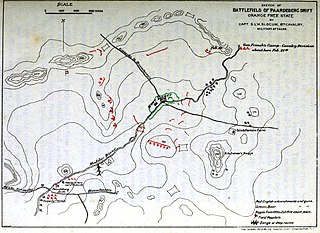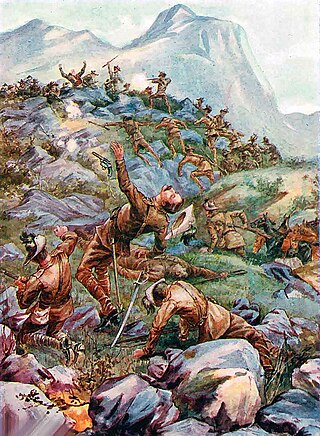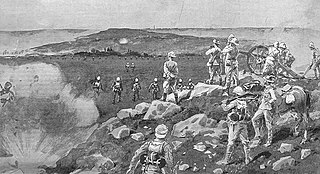
The Battle of Colenso was the third and final battle fought during the Black Week of the Second Boer War. It was fought between British and Boer forces from the independent South African Republic and Orange Free State in and around Colenso, Natal, South Africa on 15 December 1899.

The Battle of Paardeberg or Perdeberg was a major battle during the Second Anglo-Boer War. It was fought near Paardeberg Drift on the banks of the Modder River in the Orange Free State near Kimberley.

The Battle of Magersfontein was fought on 11 December 1899, at Magersfontein, near Kimberley, South Africa, on the borders of the Cape Colony and the independent republic of the Orange Free State. British forces under Lieutenant General Lord Methuen were advancing north along the railway line from the Cape to relieve the siege of Kimberley, but their path was blocked at Magersfontein by a Boer force that was entrenched in the surrounding hills. The British had already fought a series of battles with the Boers, most recently at Modder River, where the advance was temporarily halted.

The Battle of Stormberg was the first British defeat of Black Week, in which three successive British forces were defeated by Boer irregulars in the Second Boer War.

The Battle of Berg-en-dal took place in South Africa during the Second Anglo-Boer War.
The Battle of Sanna's Post was an engagement fought during the Second Boer War (1899–1902) between the British Empire and the Boers of the two independent republics of the Orange Free State and the South African Republic.
The 14th Infantry Brigade was a British Army formation during the Second Boer War, World War I, when it served on the Western Front, and World War II, when it fought in Crete and Tobruk, and then as Chindits in Burma.

The Great Boer War is a non-fiction work on the Boer War by Arthur Conan Doyle and first published in 1900 by Smith, Elder & Co. By the end of the war in 1902 the book had been published in 16 editions, constantly revised by Doyle. The Introduction describes the book as:
A very thorough account, including tables at the end of those killed or wounded up until the 8th September when he left South Africa. This account is compiled with as much accuracy as was attainable at this date, and with as much detail as a single volume will permit. In frequent conversations with Boers, Conan Doyle has endeavoured to get their views upon both political and military questions. Often the only documents he had to consult were the convalescent officers and men under his care, therefore some errors may have crept in. The closing scenes of the Boer War have necessarily been treated with less detail than the earlier.

The Battle of Diamond Hill (Donkerhoek) was an engagement of the Second Boer War that took place on 11 and 12 June 1900 in central Transvaal.

The Boer Commandos or "Kommandos" were volunteer military units of guerilla militia organized by the Boer people of South Africa. From this came the term "commando" into the English language during the Second Boer War of 1899–1902 as per Costica Andrew.

The siege of Kimberley took place during the Second Boer War at Kimberley, Cape Colony, when Boer forces from the Orange Free State and the Transvaal besieged the diamond mining town. The Boers moved quickly to try to capture the area when war broke out between the British and the two Boer republics in October 1899. The town was ill-prepared, but the defenders organised an energetic and effective improvised defence that was able to prevent it from being taken.
Marshall's Horse was a South African cavalry unit formed in 1899 at the start of the Second Boer War to provide military support for the British campaign. The unit was created from the Uitenhage Rifles and 1st City (Grahamstown) Volunteers. They formed in Grahamstown, initially comprising 244 members before rising to 500 in late 1899. The unit's first commanding officer was Major George Marshall CMG.

The Battle of Poplar Grove was an incident on 7 March 1900 during the Second Boer War in South Africa. It followed on from the Relief of Kimberley as the British Army moved to take the Boer capital of Bloemfontein. The Boers were demoralised following the surrender of Piet Cronjé at the Battle of Paardeberg. General Sir John French's cavalry attacked the Boer force from the rear while mounted infantry and horse artillery attacked from the right flank. The Boers abandoned their positions in panic before the cavalry. The commander-in-chief of the Free State forces, Christiaan de Wet, in his book called the chapter on the subject "Wild Flight from Poplar Grove". This battle was followed by the Battle of Driefontein on March 10, 1900.

The Battle of Elands River was an engagement of the Second Boer War that took place between 4 and 16 August 1900 in western Transvaal. The battle was fought at Brakfontein Drift near the Elands River between a force of 2,000 to 3,000 Boers and a garrison of 500 Australian, Rhodesian, Canadian and British soldiers, which was stationed there to protect a British supply dump that had been established along the route between Mafeking and Pretoria. The Boer force, which consisted of several commandos under the overall leadership of Koos de la Rey, was in desperate need of provisions after earlier fighting had cut it off from its support base. As a result, it was decided to attack the garrison along the Elands River in an effort to capture the supplies located there.
21st Brigade was an infantry formation of the British Army first organised in the Second Boer War, when it took part in Ian Hamilton's March from Bloemfontein to Pretoria. Reformed in World War I it served under the command of first 7th Division and then 30th Division, fighting in most of the major battles on the Western Front from the First Battle of Ypres to the Armistice. It was briefly re-raised in the Sudan early in World War II before being transferred to the Indian Army.

The Battle of Driefontein on 10 March 1900 followed on the Battle of Poplar Grove in the Second Boer War between the British Empire and the Boer republics, in what is now South Africa. In the first half of 1900, the British made an offensive towards the two Boer republic capitals of Bloemfontein and Pretoria.

Pieter Daniël de Wet was a Boer general in the Anglo-Boer War (1899–1902) and a younger brother of Boer general and politician Christiaan de Wet. Piet de Wet participated in the Battle of Poplar Grove, the Battle of Sanna's Post for the waterworks there, and defeated the 13th Battalion Imperial Yeomanry at Lindley. In July 1900, he surrendered to the British at Kroonstad, Orange Free State. He became a prominent member of the National Scouts helping the British in the last years of the Boer War.

The Advance on Pretoria was a military operation during the Second Boer War. From May–June 1900, Lord Roberts and his force began a strategic offensive from Bloemfontein to Pretoria, with the goal of capturing the Pretoria, the capital of the South African Republic (Transvaal) in hopes of ending the war, and forcing the Boers into surrendering. After the clearing of the South East of the Orange Free State, Lord Roberts began his offensive on 3 May 1900, gathering a force around 40,000-50,000 strong. The Army formed three lines of advance. On the far left, a force commanded by Lord Methuen advanced from Boshof, in the center, Lord Roberts led the main army up the railway from Bloemfontein to Pretoria, and on the right, Redvers Buller led an army up through Northern Natal from Ladysmith to Pretoria. The military operation was a success, with British Forces entering Pretoria on 5 June, and the Boers surrendering the capital shortly after. On 8 June, the country was annexed, and formed into the Transvaal Colony in 1902. Methuen managed to clear the Orange Free State, and had a force relieve Mafeking whilst doing so.

The Battle of Laing's Nek from 2–10 June 1900 was a series of actions in the Second Boer War between forces under Redvers Buller and the Boers of the Transvaal. At the time, Redvers Buller was advancing from Ladysmith to the Buffalo River, in an effort to cross into Volskrust, where he could then aid Lord Roberts in the Advance on Pretoria. The Boers had fortified themselves at Laing's Nek, as they had done previously 18 years prior. Over the course of eight days, Buller was able to repulse the Boers, and cross the Buffalo River into Transvaal on 12 June.

The Battle of Veertien Strome was a military engagement in the Second Boer War fought near Warrenton, Northern Cape by Boer troops under Sarel du Toit and British troops under Paul Methuen. Du Toit failed to prevent the British from crossing the Vaal River and entering the South African Republic from the southwest. It was part of Methuen's clearing of the Orange Free State, which was a part of the larger military Advance on Pretoria.


















